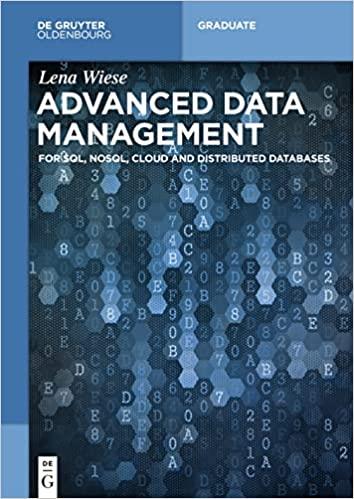Answered step by step
Verified Expert Solution
Question
1 Approved Answer
Write a complete Java program to do the following: The main program will call a series of methods to process a set of data. One
Write a complete Java program to do the following:
The main program will call a series of methods to process a set of data. One method will read data into an array. A second method will print the values stored in an array in a neat format. Another method will find the average of the values stored in an array. A fourth method will construct a new array from an existing array.
Here are the details on the main program:
The main program will read in a parameter value which the main program will call size Note that the main program reads this value, not one of the methods.
The main program will call a method readData to read size items into an array which the main program will call first or something else of your choice
The main program will call a method printArray which will print the values stored in the first array. Before the main program calls the printing method, it should print a heading saying what is being printed eg the heading could say "here is the original array"
The main program will call a method findAverage which will find the average of the size values stored in the first array. The main program will print this value, together with a relevant message.
The main program will call a method howFarAway which will construct a new array called second from the original array first. The details are described below.
The main program will call the method printArray again, to find the values stored in the new array made in part The main program will print an appropriate message eghere is the new array before it calls this method.
The main program will call the method findAverage again, to find the average of the values stored in the new array made in part The main program will print the value with a message.
Here are the details on the methods:
A The method readData will read data into an array. The method will receive two parameters: an integer n and an array of doubles called numbers. At the beginning, n will have a value, and the array will be empty. The method will read n lines of data. Each line of data should contain a number of type double so it might have decimal places The values stored in this array will be sent back to the main program, to be used throughout the program.
B The method printArray will receive two parameters, an integer q and an array of doubles called numb. It will print the q values stored in the array numb, spaced neatly across a line, with two decimal places for each value. Format the output to create neat columns. For example, if q is then values will print on the first line, on the second line,
and on the third, as
shown to the right. If there are
values, then the th should print on
a fourth line, and so on
C The method findAverage will receive two parameters, an integer k and an array of doubles called p It will find and return the average of the first k elements of the p array.
D The method howFarAway will receive four parameters: an integer m the average of the array as calculated in the average method, and two arrays of doubles called r and sHere r is the original array and s is the new array to be constructed. Alternately, you can return the new array s instead of passing it as a parameter. Each element in the new array s will equal the difference between the original arrays average and the corresponding element in the original array r
For example, if the original array holds then the average is ; the new array will hold Note that some of these elements are positive and some are negative.
DATA: Read the data from a file which is to be prepared in advance be sure to print the file Use a parameter value of but write a program which will work for any size arrays up to or so Make sure that the numbers are not in order, and make sure that they are spread out. It is not necessary to have decimal places in every value, but a few should. Include both positive and negative values. PRINT A COPY OF THE DATA FILE.
Also, all output should be directed to an output file, not the screen.
OPTIONAL Call a method to find the value which is closest and furthest from the average. The method should print these values and how far from the average they are. Remember that you may have positive or negative values.
Step by Step Solution
There are 3 Steps involved in it
Step: 1

Get Instant Access to Expert-Tailored Solutions
See step-by-step solutions with expert insights and AI powered tools for academic success
Step: 2

Step: 3

Ace Your Homework with AI
Get the answers you need in no time with our AI-driven, step-by-step assistance
Get Started


